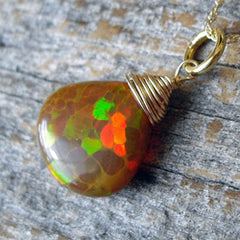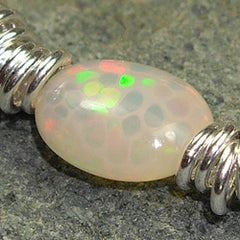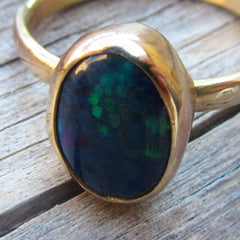Your Cart is Empty
🇬🇧 FREE UK Shipping on all orders over £50 🌎 International Shipping Available
🇬🇧 FREE UK Shipping on all orders over £50 🌎 International Shipping Available
Jewellery
Buying Guide: Honeycomb Opal Jewelry
October 23, 2017 5 min read
Shop our exclusive collection of one of a kind jewelry with Honeycomb Opals, or read on for information about Honeycomb Opal, where to buy Honeycomb Opal jewelry and how to care for these amazing Opals.



When most people think of Opal, they imagine a white opaque gem with some color flashes across its surface. Those more familiar with Opals may think of other colors such as black Opal or Fire Opals, however, few people are familiar with the rare variety of Opal known as a Honeycomb Opal.
Honeycomb Opals have their name because they display an unusual natural pattern resembling a honeycomb. This pattern displays cells of color across the surface of the gem, and in more transparent honeycomb Opals, these cells have visible depth to them making them further resemble a piece of honeycomb captured within the gem. Often, a cross-section of the cell columns can be viewed from the side of the gem if the cell columns have been cut into when cutting and polishing the gem.
Each of the cells in a honeycomb Opal usually displays color. The cell colors can be the same color in every cell or the Opal can display a variety of colored cells in every color of the rainbow that look amazing when the gem is moved.
Although these rare Opals resemble a honeycomb, the cells can be irregular in shape and are not perfect hexagons; most honeycomb Opals display rounded color cells in irregular shapes that resemble a cluster of bubbles.
Honeycomb Opals are usually a variety of Ethiopian Opal; the honeycomb pattern and other rare patterns are sometimes found in Australian Opals however if you see a honeycomb Opal it is far more likely to be an Ethiopian Welo Opal.



How to tell if a Honeycomb Opal is genuine:
This unusual gem looks almost too beautiful to be real and many people mistakenly believe that they aren’t genuine. As with other Ethiopian Opals, honeycomb pattern Opals from Ethiopia have an almost waxy surface feel and are incredibly lightweight, making them feel almost as if they are a type of plastic. This is however how the gem should feel and this shouldn’t be taken as an indicator that the gem is not real.
Honeycomb Opals can’t be created in a lab or man-made; some synthetic and created Opals do display cells however they present in a completely different way to honeycomb Opals and the two could not be confused by any jeweler who regularly works with honeycomb Opal.
If you are interested in purchasing a piece of honeycomb Opal jewelry, it is essential that you purchase via a jeweler who regularly works with this type of Opal and understands the gem. This ensures that the honeycomb Opal you receive is genuine, correctly set, and sold to you at an appropriate price.
Honeycomb Opal Colors and cuts:
Honeycomb Opal can be found in all of the color variations that other Ethiopian Opals are found in, such as clear crystal honeycomb pattern Opal, tan and chocolate honeycomb Opal gems, and black honeycomb Opal.
Honeycomb Opals can be color treated and smoked just like other Ethiopian Opals, however these treated gems are still genuine Opals, they just aren’t 100% natural as their color has been enhanced.
Honeycomb Opals are almost always cut into cabochons (flat back and smooth polished domed top) and almost always has a smooth polished surface, however, we occasionally see them cut into faceted ring stones and beads. Whenever we see honeycomb Opals in these ultra-rare cuts we immediately snap them up for our designs!



Are honeycomb Opals valuable?
Honeycomb Opals are highly collectible, rare and valuable. The most valuable gems are those with color cells across their entire surface in an even pattern, color cells displaying rainbow colors rather than a single color, a transparent, black or white base color, and a large size. A honeycomb Opal gem with all of these qualities in a size larger than 5 carats is a particularly rare find. Such gems are considered ‘museum quality’ Opals and command high prices.
More affordable honeycomb Opals are available and these gems tend to have less regular patterns, for example, they may have a cluster of color cells rather than color cells across their entire surface, they may have cells displaying only a single color, or they may me in a smaller size. These gems are the type of honeycomb Opals that you will usually see and find set into honeycomb Opal jewelry; the ‘museum quality’ honeycomb Opals are rarely set into jewelry and are more usually kept in private gem collections.
Tan or chocolate color Ethiopian honeycomb Opals tend to be more affordable than white, transparent or black honeycomb Opals, yet these gems are just as beautiful, and in some cases, even more stunning than their more expensive counterparts.
How to care for Honeycomb Opal:
Honeycomb Opals should be treated just like any other Ethiopian Opal. They are more durable than other Opal varieties and are ideal for use in jewelry. They are a type of hydrophane Opal which means that they absorb water and can contain up to 20% water. If your honeycomb Opal gets wet, it will change in color and transparency, usually becoming more transparent and losing its color. This change is temporary and it will revert back to its original color over the course of several days as it dries out. If your honeycomb Opal does get wet, you should let it dry out naturally; don’t try to speed up the drying process as a sudden change could harm the gem
Just like any gem, avoid chemicals such as cleaning products or perfume as these can be absorbed into the Opal and change its color. To clean your Ethiopian honeycomb pattern Opal simply use a damp non-abrasive cloth and wipe clean.

Buy Honeycomb Opal jewelry online:
Here at Biographie, we have been working with honeycomb Opals since the first Welo Opals were discovered in Ethiopia in 2008 and honeycomb pattern Opals have become one of our favorite gems. We have spent years developing a trusted network of suppliers and we know who to buy these gems from (and who not to!). We also know the true value of these rare Opals and can source them at appropriate prices, ensuring that our customers never overpay for a piece of honeycomb Opal jewelry; often, jewelers who have never seen these rare gems will overpay.
When buying honeycomb opal jewelry online it’s important to see multiple photo’s of the piece of jewelry in order to check whether the honeycomb pattern is visible from all angles or just one. Often honeycomb Opals display intense colors from a particular angle yet appear plain from other angles. Ideally, you’d want to see multiple images taken in natural sunlight, or, a video of the gem being moved.
As with other Ethiopian Opals, some honeycomb Opal jewelry retailers and jewelers alter the images of their products to enhance the appearance of the Opal. This is usually done in Photoshop and similar programs by increasing the color saturation in the image. Here at Biographie we take our Opal images in natural sunlight and never color enhance those images in order to give you a clear representation of each gems true color.
Our honeycomb Opal jewelry designs feature genuine Ethiopian honeycomb Opals set into solid gold, sterling silver and gold vermeil (gold plated sterling silver). Due to the unique qualities of each honeycomb Opal gem, each of our jewelry designs is a one of a kind piece that can’t be recreated exactly so if you see a piece of honeycomb Opal jewelry in our collection that you love, be sure to pounce on it before someone else does!
Subscribe
Sign up to get the latest on sales, new releases and more …


